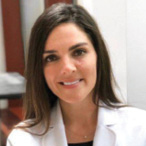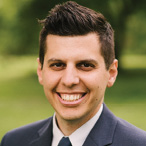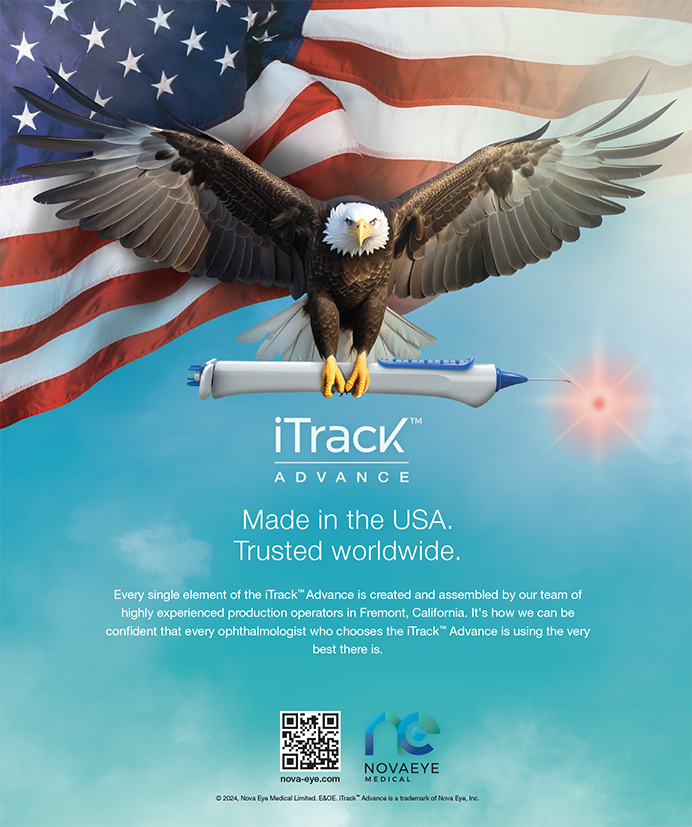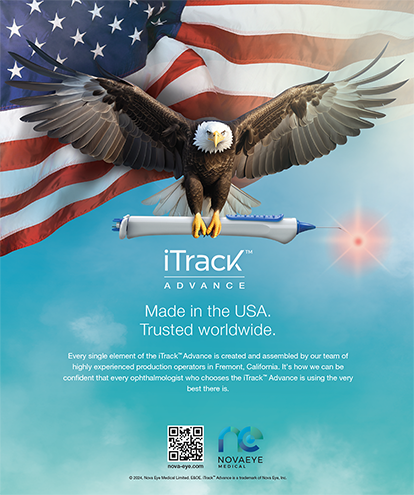



INTRODUCTION
Blake K. Williamson, MD, MPH, MS: The use of digital and social media marketing for ophthalmology has exploded in the past few years. My practice, Williamson Eye Center in Louisiana, integrated these types of campaigns long before the COVID-19 pandemic began, but many other practices really got involved with social media during the pandemic. Whether you’ve been a habitual user of social media or you’re new to the concept, this discussion should shed light on how we can leverage these opportunities not only for practice growth but also to connect with colleagues.
Mr. Sideris, you’ve worked with a lot of different doctors on social media. What are some practices that are successful in this medium of marketing?
Nick Sideris: The most successful practices are those led by surgeons who take ownership of and dedicate themselves and their teams to being consistent with social media efforts. Yes, it takes time, but it pays dividends. The three most important things you can do to grow your practice and get more patients through the door are to be dedicated to social media, stick to a social media plan, and involve your team to diversify the contributors and consistently create content that people can engage with and learn from.
DEFINE YOUR GOAL
Dr. Williamson: Dr. Lozano, one thing I noticed on your Instagram account is that you include personal posts. Do you find that patients gravitate toward this type of post? What do you get out of it?
Valentina Lozano, MD: I started my Instagram account in my first year of residency to show other medical students what an ophthalmologist does. I quickly realized that medical students were not as interested as my ophthalmology colleagues. This may not help me increase my patient volume, and I feel somewhat awkward when I see a patient follows me. I’m still trying to decide whether I want to use my social media platform for patients or to continue doing what I’m doing. Even though my typical posts are not patient-oriented, potential patients can see that I am passionate about what I do, and that’s my goal.
Dr. Williamson: Dr. Rebenitsch, your social media efforts are geared toward patients versus trying to connect with other ophthalmologists and medical professionals. Why is that?
R. Luke Rebenitsch, MD: Years ago, I used to be active on social media on a personal level. When I took over ClearSight, however, I changed direction. Now, our primary goal is to build trust with potential patients before they even come through the doors. We share why we do what we do in our practice, but we also show how we do it. Our typical social media posts include examples of patients with good outcomes who are living without limits. Our posts are fun, but they have a serious message. When the time comes for those who engage with us on social media to have refractive or cataract surgery, we hope they think of us as a fun place that’s serious about good outcomes and good technology and that cares deeply about what we do. In my opinion, you’re losing a lot of potential patients if you’re not active on social media.
Dr. Williamson: Do you have a practice champion who is in charge of social media?
Dr. Rebenitsch: We have a social media team composed of volunteers who work at our practice and are in charge of taking and posting pictures. They even created a ClearSight mascot, Brian the Sloth. These volunteers add to our social media from different facets. If you’re not having fun with social media, it comes across as inauthentic.
Dr. Williamson: We have a good time with social media at Williamson Eye Center, too, and seven or eight different people take the lead in creating posts. Mr. Sideris helped kickstart our social media efforts. One thing he taught us is to worry less about creating amazing posts and more about documenting what you’re doing and posting regularly. In other words, don’t overthink your posts—try to be raw if you can.
Mr. Sideris, does the number of followers a practice has matter? My team is great at social media, and we create posts that are geared toward growing our business and doing more surgery, but I only have about 2,000 followers. Dr. Lozano, on the other hand, has more than 13,500 followers. Am I doing something wrong?
Mr. Sideris: I think you hit the nail on the head by trying to define what your goal is. Dr. Lozano wants to connect with colleagues, whereas your practice wants to grow patient volume. Your posts are going to have a different feel. You are showcasing practice culture and positive outcomes. Dr. Lozano is showcasing personality. If you throw off the gloves and decide, “I’m going to show everything behind the scenes of what it’s like to peek inside my world,” you’re acting as an influencer. People are interested in doing business with other people. That—and clearly defining your goals—is the key to increasing engagement.
Dr. Lozano: I want to clarify one crucial point: I rarely if ever post about my personal life. Rather, I post socially about my professional life. Mr. Sideris, you asked, “What’s your goal?” My goal, I thought, wasn’t to build my business. Now that I am thinking about it, however, maybe it should be.
When I started at Los Angeles Glaucoma Group, our practice’s website had poor functionality. Your website is primarily how people find you, especially for glaucoma specialists like myself, so it was important to me to take charge and implement changes to our website. On the other hand, it might be equally or more important for refractive surgeons to emphasize direct-to-consumer marketing efforts, like Instagram and other forms of social media.
My advice is to update your website first and then segue your efforts to Facebook and Instagram. When you are redesigning your website, the most important tactic to build you practice is search engine optimization (SEO). The second most important tactic is incorporating short videos introducing yourself and your practice. Why did you pick ophthalmology? Why do you love cataract surgery? Pre- and postoperative patient testimonials are important, too.
Dr. Rebenitsch: It’s easy to overlook the importance of your website. Even baby boomers and older generations will Google doctors, just like younger generations, to find the best surgeon. A lot of the concepts derived from traditional media translate to social media. One of these is the following: Whatever medium you’re using, make sure you do it well. It does you absolutely no good to have a presence in multiple mediums when you are not doing them well. It’s more important to focus on one.
It’s also best to post about three times a week to make sure that you maintain a top-of-mind awareness. Once you feel comfortable with that medium, add another. Today, we use Facebook, Instagram, and YouTube. Most recently, we started to dabble with geofencing (see What Is Geofencing?).
What Is Geofencing?
By Laura Straub, Editor-in-Chief
One method of enticing patients to schedule a consultation or procedure is to use a location-based software program or app service to initiate a preprogrammed action whenever a smartphone or radio frequency identification (RFID) tag enters or exits a virtual geographic boundary called a geofence.1,2 Actions may include targeted marketing such as text, email, and social media advertisements. It also includes app-based notifications.
Geofencing tracks the location of the smartphone or RFID tag using GPS, Bluetooth, wifi, or cellular data. It delivers targeted messaging to smartphone and RFID tags inside a virtual perimeter built around a specific geographic location. Geofences can be built for use with mobile, tablet, and desktop devices and configured to target a certain location, demographic market area, business category, brand location, city, or state.1
1. Kemmis A. What is geofencing? Everything you need to know about location-based marketing. SmartBug. January 8, 2020. Accessed July 13, 2021. https://www.smartbugmedia.com/blog/what-is-geofencing
2. White SK. What is geofencing? Putting location to work. CIO. November 1, 2017. Accessed July 13, 2021. https://www.cio.com/article/2383123/geofencing-explained.html
EFFECTIVE SOCIAL MEDIA STRATEGIES
Dr. Williamson: Mr. Sideris, for surgeons who are trying to grow their practices, what does it take to get something seen on Facebook or Instagram today?
Mr. Sideris: Believe it or not, the use of lower-quality, nonstaged images works extremely well. When potential patients see a really beautiful photograph or stock photograph, they immediately think, “This is an ad. I’m just going to keep scrolling.” People are more inclined to stop scrolling in their feeds for a lower-quality image.
Other useful strategies include documenting what happens at your practice and repurposing segments of patient interviews and testimonials for social media use. You can also post the entire interview or testimonial on your YouTube channel, extract the audio for a podcast, and make still images of quotes for social media. It’s great to take one 20-minute piece of content and chop it up into 50 or 60 pieces of content that you can drip out slowly.
BUDGETING
Dr. Williamson: Mr. Sideris, can you share with us what a typical social media marketing budget looks like?
Mr. Sideris: The answer to this question depends upon your market. Most practices can go really far on about $1,000 per month regardless of the market. In many cases, a budget of that size forces a practice to focus on a narrow audience, which in return produces better results.
Most of the money you spend should go toward SEO, which is expensive because it’s intent-based. People are going to Google a specific procedure or term. I recommend that about 60% to 70% of a digital marketing budget be earmarked for Google pay-per-click and the remaining 40% to 30% be split between Facebook and YouTube pre-roll ads. Instagram lends itself better to creating consistent and organic content, which is technically free. You may have difficulty getting seen because of the algorithm. In terms of ad performance, however, your best spend is on Facebook because users are used to clicking on something to go to something else, whereas Instagram is a visual medium and therefore a lot harder platform to convert ads on.
Dr. Williamson: This discussion was fruitful. I want to thank our panelists for sharing their experiences using social media to grow their practices and networks with colleagues and for providing some helpful information on optimizing algorithms for visibility.




